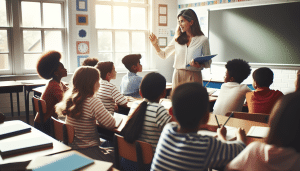Surprising Benefits of Bilingual Education in Society
Oliver Cooper September 28, 2025
Discover how embracing bilingual education can impact learning, boost cognitive development, and shape communities. This guide explores the key roles bilingual programs play in classrooms, how they prepare students for global engagement, and why these skills matter now more than ever.
Why Bilingual Education Is Gaining Attention in Schools
Bilingual education is no longer confined to language arts lessons. In classrooms worldwide, it is reshaping how students learn and interact across cultural boundaries. Recent research shows that students exposed to instruction in two languages tend to outperform their peers in problem-solving tasks. By developing proficiency in more than one language, learners acquire flexible thinking that extends beyond vocabulary. Bilingual programs often include subjects like math and science taught in both languages, challenging students to interpret and apply concepts in diverse linguistic contexts.
Many parents and teachers initially worry about cognitive overload, but data reveal the opposite. Rather than confusing young minds, managing two language systems actually sharpens attention and executive function. In communities with high immigrant populations, dual-language classrooms offer a sense of belonging and validation for students who speak a different language at home. This approach can close achievement gaps and foster greater equity, enhancing students’ long-term educational outcomes and social mobility.
The societal benefits are striking too. By promoting acceptance and cultural exchange, bilingual education lays a strong foundation for harmonious communities. Young learners become more open-minded and empathetic, qualities that extend into adulthood. As society grows more interconnected, these skills prepare students to navigate global challenges and work within diverse teams. Schools that invest in bilingual programs contribute to citizenship on both a local and international scale.
Cognitive Advantages From Learning Two Languages
Learning two languages shifts brain development in powerful ways. Bilingual learners often display more advanced skills in critical thinking, multitasking, and memory retention. Research from leading educational institutes indicates children in dual-language programs demonstrate superior mental flexibility. They can switch between tasks more efficiently and maintain focus when distractions arise. These results provide a concrete argument for embedding second language instruction early and consistently throughout the school years.
Some of the greatest impacts are neurological. MRI studies reveal that bilingual individuals have denser gray matter in areas associated with language processing and attention. This enhancement translates to stronger academic performance and lifelong benefits, including delayed onset of cognitive decline in adulthood. Building bilingual brains early can, therefore, provide a cognitive advantage well into later life stages. Such findings are prompting educators to reconsider the timing and intensity of language exposure in curricula.
What sets bilingual students apart is not just words—they learn new ways to think. The constant mental gymnastics involved in switching between languages strengthens problem-solving skills and creative reasoning. In standardized assessments, bilingual students often outperform monolingual peers, even when tested in their non-dominant language. These academic successes open doors to scholarships, selective college admissions, and expanded job opportunities. The evidence points toward a direct link between linguistic agility and broad educational achievement.
Cultural Understanding and Global Citizenship
Beyond cognitive perks, bilingual education invites learners into a richer cultural world. Students gain exposure to different perspectives and traditions, enhancing social awareness. They become more empathetic to those who come from backgrounds different from their own. This firsthand experience is vital in an increasingly multicultural society, where understanding nuances in communication and etiquette can determine personal and professional relationships.
For many, bilingualism opens doors to global citizenship. Children learn world history not just from a single viewpoint, but through diverse sources in original languages. This deepens their sense of place in a connected world and prepares them for cross-cultural collaboration. Workplaces value employees who can relate to international clients, decipher cultural subtext, and adapt products for a broader market. These abilities often originate from years spent in multicultural, bilingual classrooms.
The cultural impact ripples outward. Families of bilingual students report greater pride in their heritage and more sustained ties with relatives abroad. Community celebrations, cultural events, and language days all contribute to a vibrant social fabric. Schools become hubs where cultural exchange thrives, fostering neighborhood unity. In the long term, these layers of inclusion create stronger, more inclusive societies, less prone to misunderstandings or prejudice.
Challenges of Implementing Bilingual Curricula
Bilingual education does not come without hurdles. Recruiting teachers fluent in both target languages can be tough, especially for less commonly taught languages. Curricula must be carefully adapted to ensure all academic content is accessible and rigorous for learners in both language streams. Administrators are also tasked with navigating complex state and national education policies that may not fully support dual-language programs.
Resource allocation is another concern. Schools may need specialized textbooks, immersive language learning tools, and professional development for staff. Ensuring fair access to these resources across urban and rural districts can be an equity challenge. Some families may also feel hesitant about enrolling their children in bilingual classes, fearing a language delay or academic disadvantage—though research shows those fears are largely unfounded. Parental engagement and transparent communication about outcomes are crucial for long-term program success.
Assessment poses another layer of complexity. Students must often be evaluated in both languages, and creating accurate, fair standardized tests requires collaboration between educators and assessment developers. Nevertheless, schools that overcome these hurdles report strong academic results. Many dual-language graduates speak with pride about their experiences and cite their bilingual education as a defining factor in both career and personal growth. Over time, as evidence mounts, support and funding for such programs have continued to rise.
Bilingual Skills and the Modern Workforce
In today’s economy, bilingualism is an in-demand skill across industries. Employers increasingly value workers who can engage clients and partners across language barriers. From healthcare to engineering and international business, fluency in more than one language is seen as a key asset. Bilingual employees help companies expand into new markets, mitigate misunderstandings, and offer more tailored customer service.
The return on investment is significant. Studies suggest bilingual professionals command higher wages than their monolingual counterparts, owing to their unique ability to bridge linguistic and cultural divides. In sectors like global commerce, translation, diplomacy, and tourism, bilingual skills can be career-defining. Even within local communities, bilingual staff help organizations serve increasingly diverse populations, making them indispensable assets in schools, clinics, and social service agencies.
Beyond wage premiums, these skills foster lifelong adaptability. As automation transforms workplace demands, cognitive flexibility gained through bilingual education helps individuals learn new skills quickly. Employers note that bilingual workers often demonstrate advanced problem-solving abilities, resilience, and leadership potential. Investing in these competencies through education programs is not just a societal good—it prepares individuals for jobs that do not yet exist and economies that are rapidly evolving.
Social Impact and Community Transformation
Bilingual programs can revitalize whole communities. In areas with high linguistic diversity, offering dual-language instruction helps preserve minority languages and cultures. These efforts counteract language loss, keeping traditions alive for future generations. Neighborhoods with strong bilingual education systems often see greater civic involvement, higher graduation rates, and a sense of shared purpose among residents.
Community partnerships are critical in sustaining these gains. Local organizations, families, and civic leaders collaborate to celebrate multilingualism through festivals, tutoring, and mentorship. Such alliances foster a supportive learning environment where parents can participate in their child’s academic journey, regardless of their own language background. As students become more linguistically confident, entire neighborhoods benefit from increased social cohesion and trust.
The ripple effects extend further. By embracing bilingualism, communities attract global talent and investment, transforming local schools into hubs of innovation and exchange. Public spaces, libraries, and cultural centers become more inclusive, tailoring services and events for a broader constituency. These changes underscore the transformative, long-lasting value of embracing bilingual education—not only in schools but across society.
References
1. Center for Applied Linguistics. (n.d.). Benefits of Bilingualism. Retrieved from https://www.cal.org/resource-center/faqs/benefits-of-bilingualism
2. National Association for Bilingual Education. (n.d.). Why Bilingual Education? Retrieved from https://www.nabe.org/Why-Bilingual-Education
3. American Councils Research Center. (2021). The Cognitive Benefits of Being Bilingual. Retrieved from https://www.americancouncils.org/sites/default/files/BenefitsofBilingualism.pdf
4. U.S. Department of Education. (n.d.). Bilingual Education Programs. Retrieved from https://www2.ed.gov/about/offices/list/oela/bilingual-education.html
5. Harvard Graduate School of Education. (n.d.). The Lasting Benefits of Bilingualism. Retrieved from https://www.gse.harvard.edu/news/uk/18/10/lasting-benefits-bilingualism
6. Education Week. (n.d.). How Bilingual Education Boosts the Brain. Retrieved from https://www.edweek.org/teaching-learning/how-bilingual-education-boosts-the-brain/2019/06







